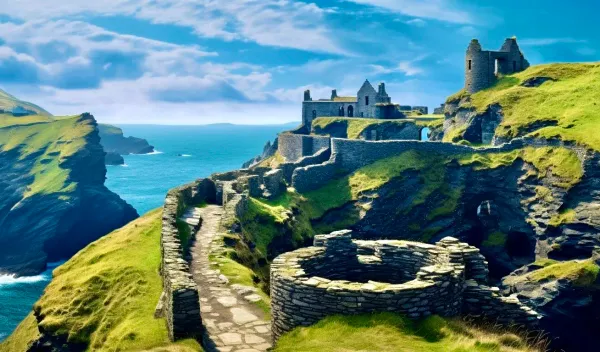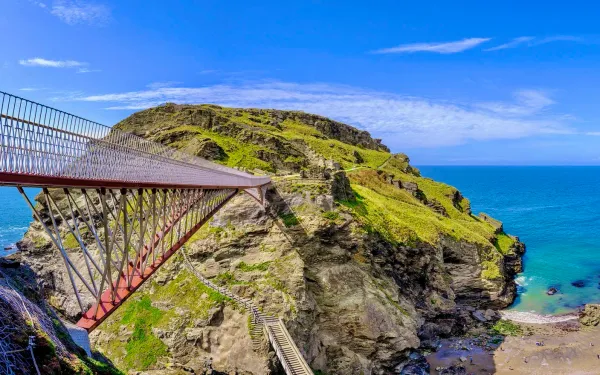Prague Sightseeing: From Castles to Charles Bridge
Discover the enchantment of Prague, a city that transcends time, in our comprehensive travel guide. From iconic landmarks like Prague Castle and Charles Bridge to hidden gems and artistic havens, our guide navigates you through a city of history, culture, and charm.

Table of Content
- Old Town Square (Staroměstské náměstí)
- Charles Bridge (Karlův most)
- A Glimpse of History: The Jewish Quarter (Josefov)
- The Majestic Prague Castle Complex (Pražský hrad)
- Discovering the Picturesque Lesser Town and Petřín Hill
- Serenity and Artistry: Kampa Island
- Prague's Cultural Essence: Art, Museums, and the Dancing House
- Beyond the Mainstream: Hidden Gems in Prague
- Making the Most of Your Prague Visit: Practical Travel Tips
Prague, the capital of the Czech Republic, is a city that beckons travelers from across the globe with its enchanting blend of history, architecture, and culture. Nestled along the meandering Vltava River, the cityscape is a magnificent tableau of Gothic and Baroque architecture, steeped in centuries of stories and legends. Prague is often referred to as "The City of a Hundred Spires," a moniker that perfectly encapsulates the mesmerizing skyline of this historical jewel in the heart of Europe.
In this comprehensive travel guide, we invite you to join us on a virtual journey through Prague's most captivating sights, as we explore the city's rich tapestry of history and culture. From the charming Old Town Square to the iconic Charles Bridge, and the majestic Prague Castle complex, each landmark we'll visit tells a unique story of the city's past and present. As we embark on this Prague sightseeing adventure, you'll discover why the city continues to be a favorite destination for travelers seeking a blend of heritage, art, and romance.
So, grab your walking shoes, and let's delve into the soul of Prague, one sight at a time. Our journey begins in the historic heart of the city, the Old Town Square.
Exploring Prague's Historic Core:
Old Town Square (Staroměstské náměstí)

Our Prague sightseeing adventure commences in the Old Town Square (Staroměstské náměstí), a bustling and picturesque hub that encapsulates the city's historical charm. This square, with its timeless architecture and vibrant atmosphere, is the ideal starting point for any traveler's journey through Prague.
1. The Old Town Hall and Astronomical Clock
At the heart of the square, the Old Town Hall stands as a symbol of Prague's rich history. The Old Town Hall is renowned for its captivating astronomical clock, the Prague Astronomical Clock (Pražský orloj). This medieval timepiece comes to life every hour with an enchanting show that has captivated visitors for centuries. Its intricate design and significance in Prague's history make it an essential stop for anyone visiting the city.
2. Street Performers and Cultural Vibrancy
As you stroll through the Old Town Square, you'll likely encounter a vibrant array of street performers, artists, and musicians adding to the square's lively atmosphere. It's here that you can take in the local culture, purchase traditional Czech souvenirs, or simply enjoy a cup of aromatic coffee at one of the many charming cafes lining the square.
Charles Bridge (Karlův most)

Leaving the Old Town Square, we make our way to another iconic landmark, Charles Bridge (Karlův most). This bridge, with its ageless beauty and historical significance, offers not only a crossing over the Vltava River but also a remarkable opportunity to soak in the city's spirit.
1. History and Significance
Charles Bridge, named after King Charles IV, has stood as a vital link between the Old Town and Lesser Town for over six centuries. The bridge's history is woven with tales of kings, nobles, and even legends of drowned builders.
2. Statues and Their Stories
One of the most distinctive features of Charles Bridge is the collection of thirty statues that line its sides. Each statue has its unique story, and some are replicas while others are the original, carefully preserved due to their historical importance.
3. Tips for a Memorable Stroll
Charles Bridge can get crowded during peak tourist seasons. To make the most of your visit, consider crossing the bridge early in the morning or during the quieter evening hours to savor its beauty without the hustle and bustle. Don't forget to take in the breathtaking views of Prague Castle and the Old Town Bridge Tower.
With these two incredible sites under our belt, we've just scratched the surface of Prague's captivating attractions. Keep reading, where we will continue our exploration of this beautiful city by venturing into the Jewish Quarter, known as Josefov, and uncovering its rich history and culture.
A Glimpse of History: The Jewish Quarter (Josefov)

As we navigate Prague's historic tapestry, our next destination is the Jewish Quarter, or Josefov, a district steeped in centuries of history and tradition. This area is a testament to the resilience and cultural significance of Prague's Jewish community. As you explore Josefov, you'll find a rich tapestry of synagogues, a historic cemetery, and the Jewish Museum, all offering unique insights into the city's diverse past.
1. The Jewish Community's Legacy
Josefov bears witness to the trials and tribulations faced by Prague's Jewish community throughout its history. Despite adversity, the Jewish Quarter has preserved its heritage, making it an essential stop for travelers keen on understanding the depth of Prague's cultural diversity.
2. The Historic Synagogues
Among the notable landmarks in Josefov are its historic synagogues. The Spanish Synagogue, the Pinkas Synagogue, and the Klausen Synagogue are some of the significant ones that you can explore to learn about the community's spiritual and cultural life.
3. The Jewish Cemetery
A visit to the Jewish Cemetery, with its uneven gravestones and crowded tombs, is an evocative experience. It's a tangible representation of the long history of the Jewish community in Prague and the challenges they faced.
4. The Jewish Museum
For a comprehensive understanding of the Jewish Quarter, a visit to the Jewish Museum is highly recommended. The museum's collections include artifacts, documents, and exhibits that provide a profound insight into the community's history, art, and customs.
5. Maintaining Tradition in the Modern-Day
Josefov also encapsulates the modern-day Jewish community's vitality. While it's a historical district, you'll find contemporary Jewish culture interwoven into its fabric, from kosher restaurants to cultural events.
As you leave Josefov, you'll carry with you a deeper appreciation of Prague's diverse history and the importance of preserving cultural heritage. Our journey through Prague's enchanting sights continues in the next section as we ascend to the heights of Prague Castle, where the city's royal past unfolds.
The Majestic Prague Castle Complex (Pražský hrad)

Leaving behind the rich history of Josefov, our Prague sightseeing adventure now leads us to the crown jewel of the city's architectural splendor—the Prague Castle complex. This monumental structure, perched on a hill overlooking the Vltava River, is a symbol of the Czech Republic's royal legacy and a testament to the country's rich history.
1. Prague Castle: A Historical Marvel
Prague Castle is no ordinary castle; it's a complex that houses an amalgamation of historical treasures, architectural marvels, and cultural heritage. Its foundations were laid in the 9th century, making it one of the oldest castles in the world.
2. St. Vitus Cathedral: A Gothic Masterpiece
One of the standout features of the castle complex is the St. Vitus Cathedral. This colossal Gothic cathedral dominates the skyline of Prague and is the final resting place of Czech kings and queens. Its intricate facade and breathtaking stained glass windows are sure to leave you in awe.
3. The Golden Lane
A visit to Prague Castle is incomplete without exploring the charming Golden Lane (Zlatá ulička). This narrow alleyway, lined with small, colorful houses, provides a glimpse into the lives of castle workers in the 16th century.
4. Practical Tips for Visiting Prague Castle
- Opening Hours: The castle complex can get quite busy, so consider arriving early in the morning to avoid the crowds.
- Entrance Fees: Check the latest ticket prices and whether they include entry to specific parts of the complex.
- Changing of the Guard: Catch the changing of the guard ceremony, which occurs daily at noon, at the castle gates.
After an immersive exploration of Prague Castle, you'll undoubtedly leave with a profound appreciation for the city's historical legacy. In the next section, we will descend from the castle heights and explore the picturesque Lesser Town, or Malá Strana, along with the serene beauty of Petřín Hill.
Discovering the Picturesque Lesser Town and Petřín Hill

After immersing ourselves in the history and grandeur of Prague Castle, our journey leads us to the charming district of Lesser Town, or Malá Strana. As we explore this idyllic part of the city, we'll encounter baroque architecture, leafy gardens, and the tranquil beauty of Petřín Hill.
1. Malá Strana: Baroque Beauty
Malá Strana is a district characterized by winding, cobblestone streets, baroque facades, and a serene atmosphere. It's a stark contrast to the bustling Old Town and offers a more tranquil, yet equally enchanting Prague experience.
2. Prague's Lesser Town Square
Start your exploration in Lesser Town Square, a spacious and picturesque square featuring historical buildings, including the stunning St. Nicholas Church. Enjoy a leisurely stroll and perhaps stop at one of the charming cafés to savor a cup of traditional Czech coffee.
3. Petřín Hill: A Verdant Escape
A short walk from Lesser Town Square, you'll find the entrance to Petřín Hill. This green oasis offers a respite from the urban landscape. Among the attractions on Petřín Hill, don't miss:
- Petřín Lookout Tower: Often compared to the Eiffel Tower, the Petřín Lookout Tower offers breathtaking panoramic views of Prague.
- Petřín Gardens: These beautifully manicured gardens are a lovely place for a leisurely walk or a picnic. The gardens are particularly stunning in the spring and summer months.
4. Exploring Malá Strana's Quaint Streets
Take time to wander the charming streets of Malá Strana, where you'll discover hidden gems, from small churches to cozy restaurants serving traditional Czech cuisine.
Keep reading about our next destination - the riverfront and the serene Kampa Island. This tranquil spot provides another layer of Prague's cultural richness.
Serenity and Artistry: Kampa Island

Our journey through Prague's captivating sights now leads us to Kampa Island, a serene escape nestled along the Vltava River. Kampa Island offers a perfect blend of tranquility and artistic beauty, making it a unique and essential stop for any traveler exploring Prague.
1. The Riverside Beauty of Kampa Island
Kampa Island is often referred to as the "Venice of Prague" due to its waterfront location and charming canals. It's a peaceful sanctuary where you can enjoy leisurely walks and idyllic views of the river and the surrounding cityscape.
2. Museum Kampa: Contemporary Central European Art
One of the island's notable attractions is the Museum Kampa. This museum is renowned for its collection of contemporary Central European art, including works by famous Czech artists like František Kupka and other influential figures.
3. Wallenstein Gardens: A Baroque Marvel
Adjacent to Kampa Island, you'll find the magnificent Wallenstein Gardens (Valdštejnská zahrada), a beautifully landscaped baroque garden surrounding the Wallenstein Palace. It's an ideal spot for a leisurely stroll and a visit to the enchanting garden grotto.
4. John Lennon Wall: A Tribute to Love and Peace
A visit to Kampa Island wouldn't be complete without exploring the colorful John Lennon Wall. This ever-changing mural serves as a symbol of peace, love, and artistic expression and is an intriguing spot for photography.
As we depart from the artistic charm of Kampa Island, our Prague sightseeing journey continues with a closer look at the city's art and culture in the next section. We will explore the diverse cultural offerings, including the National Gallery in Prague and the unconventional Dancing House.
Prague's Cultural Essence: Art, Museums, and the Dancing House

As our journey through Prague continues, we find ourselves immersed in the city's vibrant art and culture scene. From world-class museums to iconic architectural wonders, Prague offers an enriching cultural experience.
1. National Gallery in Prague
The National Gallery in Prague is a treasure trove of art and culture, boasting an extensive collection of Czech and international masterpieces. Here's what to expect when you visit:
- The Trade Fair Palace (Veletržní palác): Home to a remarkable collection of modern and contemporary art, including works by renowned artists such as Picasso and Kupka.
- Schwarzenberg Palace (Švamberk Palace): This Renaissance palace houses a selection of European art spanning several centuries, making it a must-visit for art enthusiasts.
2. Dancing House: Where Modern Meets Classic
The Dancing House (Tančící dům) is an architectural masterpiece that stands in striking contrast to Prague's historical buildings. Designed by Frank Gehry and Vlado Milunić, the structure's unconventional design makes it appear as if it's dancing. A visit to the Dancing House offers a unique perspective on the city's architectural evolution.
3. Prague Castle's Art Collections
Don't forget to explore the art collections within Prague Castle, which include historic paintings, sculptures, and decorative art. Each piece tells a story of the city's royal history and cultural heritage.
4. Prague's Art Scene
Beyond the major institutions, Prague's vibrant art scene extends to numerous galleries, studios, and street art. Take time to explore the local art community, where you'll find everything from contemporary exhibitions to grassroots initiatives.
In the next section, we'll journey off the beaten path to discover some hidden gems and alternative attractions in Prague, including Vyšehrad and the famous Lennon Wall.
Beyond the Mainstream: Hidden Gems in Prague

While Prague's most iconic landmarks are captivating, the city holds a wealth of hidden gems and alternative attractions that are equally captivating and unique. In this section, we explore some of these lesser-known yet charming corners of the city.
1. Strahov Monastery
Strahov Monastery, situated in the Hradčany district on the western side of the Vltava River, is a historical gem that has stood the test of time for nearly a millennium. Founded in 1140 by Bishop Jindřich Zdík and Duke Vladislav II, Strahov Monastery is not only a place of religious significance but also a center of culture and learning.
The monastery boasts a stunning architectural blend of Romanesque and Baroque styles, with its twin spires dominating the skyline. Its most renowned treasures lie within the library. The Strahov Library houses an extensive collection of rare books and manuscripts, some dating back to the 9th century, making it a haven for bibliophiles and scholars. The library's magnificent Baroque Philosophical Hall and Theological Hall are adorned with intricate frescoes and ornate decor.
Visitors can also explore the Strahov Gallery, featuring a remarkable collection of art, including medieval manuscripts, sculptures, and paintings.
The monastery's serene courtyards and gardens offer a tranquil escape from the bustling city, making it a popular destination for both tourists and locals. Strahov Monastery is a testament to the enduring legacy of history, culture, and spirituality in the heart of Prague, inviting all to appreciate its rich heritage.
2. Wallenstein Palace: Baroque Masterpiece in Prague
Wallenstein Palace, located in the heart of Prague's Lesser Town (Mala Strana), is a magnificent Baroque masterpiece that captures the essence of European aristocracy. Built in the 17th century by the ambitious and enigmatic Albrecht von Wallenstein, it stands as a testament to wealth, power, and architectural splendor.
The palace's most striking feature is the grand, frescoed ceiling of its main hall, adorned with allegorical scenes. Today, it houses the Czech Senate, making it an architectural gem that also plays a role in modern governance. Visitors can explore its stunning gardens, and during the summer, enjoy classical concerts in the courtyard, combining history, art, and culture in one remarkable location.
3. Vyšehrad: A Place of Legends
Venturing south of the city center, we discover Vyšehrad, a historic fort known for its legends and splendid views. Highlights include:
- The Basilica of St. Peter and St. Paul: A stunning neo-Gothic church that rivals the grandeur of St. Vitus Cathedral.
- Vyšehrad Cemetery: The final resting place of many Czech luminaries, including composer Antonín Dvořák and artist Alphonse Mucha.
- Vyšehrad Gardens: These peaceful gardens offer a tranquil escape from the city's hustle and are an excellent spot for a leisurely stroll.
4. John Lennon Wall: A Tribute to Love and Peace
Tucked away in the Mala Strana district, the John Lennon Wall stands as a colorful tribute to love and peace. Covered in vibrant graffiti and messages, it's a symbol of artistic expression and a nod to the ideals embodied by the legendary musician.
5. Vytopna Railway Restaurant: Quirky Dining Experience
For a unique dining experience, visit the Vytopna Railway Restaurant. Here, your drinks are delivered by model trains, creating an enchanting atmosphere that appeals to visitors of all ages.
6. Museum of Communism: A Glimpse into the Past
To delve into Prague's more recent history, consider a visit to the Museum of Communism. The museum offers interactive displays and exhibitions that shed light on the city's life during the communist era.
7. Experiencing Prague's Alternative Art Scene
Prague's alternative art scene is thriving, with many underground galleries, street art, and unconventional exhibitions. Keep an eye out for these hidden treasures, which provide a fresh and modern perspective on the city's culture.
As we wrap up our exploration of Prague's hidden gems and alternative attractions, we'll conclude with a section that offers practical travel tips, including when to visit and how to make the most of your trip to this enchanting city.
Making the Most of Your Prague Visit: Practical Travel Tips

Before you embark on your journey to explore the captivating city of Prague, it's wise to be well-prepared. Here are some practical travel tips to ensure that you make the most of your visit:
1. Best Times to Visit
Prague experiences a wide range of weather conditions throughout the year. Consider these seasonal factors when planning your trip:
Spring (April to June): Mild weather, blooming gardens, and fewer tourists make this a popular time to visit.
Summer (June to August): Warm and sunny weather attracts the most tourists. Expect crowds at major attractions.
Autumn (September to November): A pleasant time with fewer tourists, beautiful fall foliage, and mild temperatures.
Winter (December to March): A magical time for Christmas markets, but also the coldest season. Fewer tourists are seen in the winter months.
2. Prague Card
Consider purchasing a Prague Card, which offers free entry to many museums and attractions, unlimited public transportation, and discounts at various restaurants and shops. It's an excellent way to save money and time during your visit.
3. Language and Currency
The official language is Czech, but many locals, especially in the tourist areas, speak English. The currency used in Prague is the Czech Koruna (CZK). Credit cards are widely accepted, but it's advisable to carry some cash for small purchases and in case you visit places that do not accept cards.
4. Public Transportation
Prague has an efficient public transportation system that includes trams, buses, and a metro. Consider purchasing a travel pass for unlimited travel during your stay. It's a cost-effective way to get around the city.
5. Safety and Health
Prague is a relatively safe city for travelers, but it's always a good idea to take basic precautions. Keep an eye on your belongings and be aware of your surroundings. European Health Insurance Cards (EHIC) provide healthcare coverage for EU citizens; non-EU travelers should have comprehensive travel insurance.
6. Respect Local Customs
Remember to be respectful when visiting places of worship and cultural sites. Dress modestly in churches and synagogues, and don't forget to turn off your phone's ringer when entering these places.
7. Sample Czech Cuisine
Taste the local cuisine, which includes dishes like goulash, trdelník (sweet pastry), and hearty Czech dumplings. Don't forget to try the world-famous Czech beer in a traditional pub.
8. Souvenirs and Shopping
Prague is known for its exquisite crystal and glassware, marionettes, wooden toys, and traditional Czech garnet jewelry. Souvenir shops and markets offer a wide range of options.
With these practical travel tips in mind, you're well-equipped to make the most of your journey through the stunning city of Prague.
Conclusion:
In the heart of Europe, Prague awaits, ready to share its secrets, splendor, and soul. This enchanting city transcends time, offering a delightful blend of history, culture, and charm. From the iconic Prague Castle to the quirky delights of Vytopna Railway Restaurant, every corner reveals another chapter of a story that spans centuries. Prague's history flows through its streets, reflected in its residents' eyes and celebrated in its culture.
It is a city where tradition meets innovation, where past and present intertwine. As you set out to explore Prague's historic core, remember that you're experiencing a piece of living history, a work of art. In the heart of Europe, Prague awaits, ready to share its secrets, its splendor, and its soul. Safe travels, explorers, and may the charm of Prague accompany you on your adventures, near and far.
We hope this guide has inspired your Prague adventure and provided you with valuable insights to ensure a memorable and fulfilling visit to the "City of a Hundred Spires."





